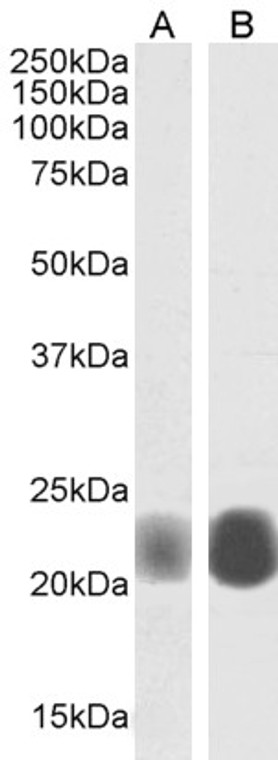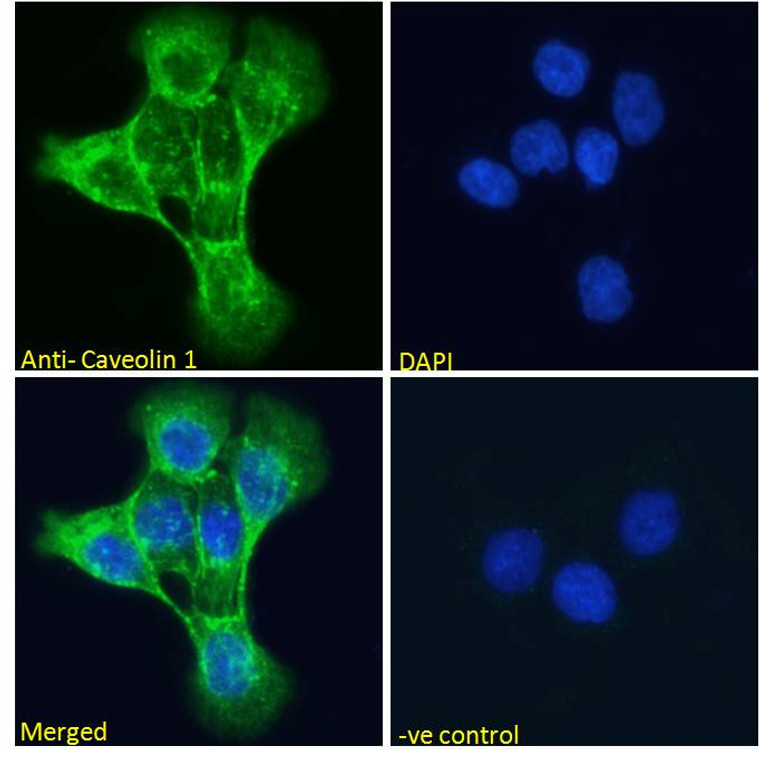| Host: | Goat |
| Applications: | Pep-ELISA/WB/IF/IHC/FC |
| Reactivity: | Human/Mouse/Rat/Dog/Pig |
| Note: | STRICTLY FOR FURTHER SCIENTIFIC RESEARCH USE ONLY (RUO). MUST NOT TO BE USED IN DIAGNOSTIC OR THERAPEUTIC APPLICATIONS. |
| Short Description: | Goat polyclonal antibody anti-Caveolin 1 (Internal) is suitable for use in ELISA, Western Blot, Immunofluorescence, Immunohistochemistry and Flow Cytometry research applications. |
| Clonality: | Polyclonal |
| Conjugation: | Unconjugated |
| Isotype: | IgG |
| Formulation: | 0.5 mg/ml in Tris saline, 0.02% sodium azide, pH7.3 with 0.5% bovine serum albumin. NA |
| Purification: | Purified from goat serum by ammonium sulphate precipitation followed by antigen affinity chromatography using the immunizing peptide. |
| Concentration: | 0.5 mg/mL |
| Dilution Range: | WB-0.001-0.01µg/mlIHC-2.5µg/mlIF-Strong expression of the protein seen in the Golgi and membranes of A431 cells and in the cytoplasm and Golgi of U2OS cells. 10µg/mlELISA-antibody detection limit dilution 1:8000. |
| Storage Instruction: | Store at-20°C on receipt and minimise freeze-thaw cycles. |
| Gene Symbol: | CAV1 |
| Gene ID: | 857 |
| Uniprot ID: | CAV1_HUMAN |
| Immunogen Region: | Internal |
| Accession Number: | NP_001744.2; NP_001166366.1 |
| Specificity: | This antibody is expected to recognize both reported isoforms (NP_001744.2; NP_001166366.1). Reported variants represent identical protein: NP_001166367.1, NP_001166368.1, NP_001166366.1. No cross-reactivity expected to Caveolin 2 and Caveolin 3 |
| Immunogen Sequence: | DELSEKQVYDAH |
| Post Translational Modifications | Ubiquitinated. Undergo monoubiquitination and multi- and/or polyubiquitination. Monoubiquitination of N-terminal lysines promotes integration in a ternary complex with UBXN6 and VCP which promotes oligomeric CAV1 targeting to lysosomes for degradation. Ubiquitinated by ZNRF1.leading to degradation and modulation of the TLR4-mediated immune response. The initiator methionine for isoform 2 is removed during or just after translation. The new N-terminal amino acid is then N-acetylated. Phosphorylated at Tyr-14 by ABL1 in response to oxidative stress. |
| Function | May act as a scaffolding protein within caveolar membranes. Forms a stable heterooligomeric complex with CAV2 that targets to lipid rafts and drives caveolae formation. Mediates the recruitment of CAVIN proteins (CAVIN1/2/3/4) to the caveolae. Interacts directly with G-protein alpha subunits and can functionally regulate their activity. Involved in the costimulatory signal essential for T-cell receptor (TCR)-mediated T-cell activation. Its binding to DPP4 induces T-cell proliferation and NF-kappa-B activation in a T-cell receptor/CD3-dependent manner. Recruits CTNNB1 to caveolar membranes and may regulate CTNNB1-mediated signaling through the Wnt pathway. Negatively regulates TGFB1-mediated activation of SMAD2/3 by mediating the internalization of TGFBR1 from membrane rafts leading to its subsequent degradation. |
| Protein Name | Caveolin-1 |
| Database Links | Reactome: R-HSA-163560Reactome: R-HSA-203615Reactome: R-HSA-203641Reactome: R-HSA-210991Reactome: R-HSA-4641262Reactome: R-HSA-5218920Reactome: R-HSA-8980692Reactome: R-HSA-9009391Reactome: R-HSA-9013026Reactome: R-HSA-9013106Reactome: R-HSA-9013148Reactome: R-HSA-9013149Reactome: R-HSA-9013404Reactome: R-HSA-9013405Reactome: R-HSA-9013406Reactome: R-HSA-9013407Reactome: R-HSA-9013408Reactome: R-HSA-9013409Reactome: R-HSA-9013423Reactome: R-HSA-9035034Reactome: R-HSA-9617828Reactome: R-HSA-9696264Reactome: R-HSA-9696270Reactome: R-HSA-9696273Reactome: R-HSA-9735871Reactome: R-HSA-9755779 |
| Cellular Localisation | Golgi Apparatus MembranePeripheral Membrane ProteinCell MembraneMembraneCaveolaMembrane RaftGolgi ApparatusTrans-Golgi NetworkColocalized With Dpp4 In Membrane RaftsPotential Hairpin-Like Structure In The MembraneMembrane Protein Of Caveolae |
| Alternative Antibody Names | Anti-Caveolin-1 antibodyAnti-CAV1 antibodyAnti-CAV antibody |
Information sourced from Uniprot.org
12 months for antibodies. 6 months for ELISA Kits. Please see website T&Cs for further guidance










![Anti-Caveolin-1 antibody [4D6] (STJ16101692) Anti-Caveolin-1 antibody [4D6] (STJ16101692)](https://cdn11.bigcommerce.com/s-zso2xnchw9/images/stencil/300x300/products/152198/347050/STJ16101692_1__64965.1681999308.png?c=1)
